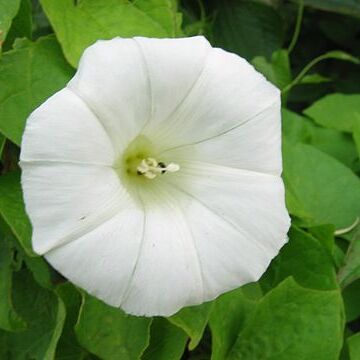Herbs prostrate or erect to twining to several meters tall, rhizomatous [or woody at base]. Leaves subsessile to petiolate, oblong to hastate or sagittate [or rarely pedate]. Inflorescences axillary, 1-flowered [or few-flowered] cymes; bracteoles 2, sepal-like, inserted immediately below calyx, ovate and sometimes saccate, enclosing calyx [or remote from calyx and subulate or leaf-shaped], persistent. Sepals subequal, persistent. Corolla white, pink [or pale yellow], funnelform, with 5 distinct midpetaline bands, glabrous. Stamens included, equal. Pollen globose, pantoporate, not spiny. Ovary 1-loculed, 4-ovuled. Style 1, included in corolla; stigmas 2, clavate. Capsule globose, glabrous, indehiscent. Seeds 4, smooth or minutely tuberculate.
Perennial rhizomatous herbs with twining, creeping or rambling, usually glabrous stems. Latex present. Lvs petiolate, entire or basally lobed and often sagittate. Fls solitary, axillary, subtended by 2 large bracts partly or entirely concealing calyx. Sepals 5, subequal. Corolla of 5 shallow lobes, usually funnelform, sometimes campanulate, nearly always white or pink with white mid-petaline bands. Stamens 5, adnate to lower part of corolla tube, included. Ovary 1-locular or imperfectly 2-locular; ovules 4. Style included; stigma 2-lobed, included. Capsule 4-celled, ovoid to globose. Seeds usually smooth and glabrous.
Fls solitary, subtended by 2 large bracts enclosing calyx, on axillary peduncles. Sepals or calyx-lobes subequal; corolla funnelform, 5-angled. Staminal filaments dilated at base. Ovary 1-or imperfectly 2-loculed and 4-ovuled. Style filiform; stigmas 2, broad. Capsule subglobose, us. 1-celled, seed glab. Twining lianes or prostrate to rambling us. glab. herbs with alt. entire or lobed lvs. Some 10 spp., mostly of temperate regions. No N.Z. sp. is endemic.
Much like Convolvulus in aspect, but the bracts usually large, inserted just beneath the cal, and ± concealing it; pollen spheroidal, pantoporate with 20–40 apertures; ovary ± unilocular, the partition incomplete; stigmas oblong, ± cylindric, blunt; fls usually solitary; our spp. rhizomatous perennials. 30, widespread.

